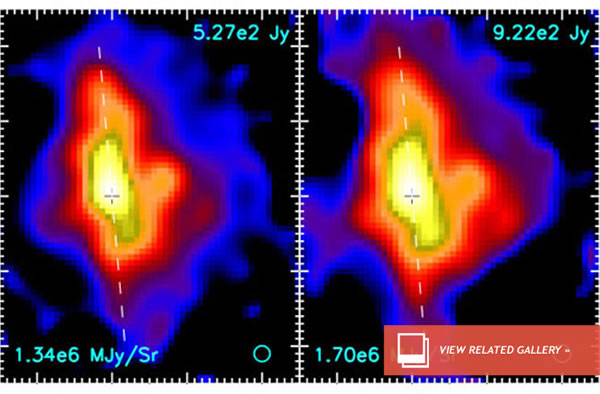SOFIA Discovers a Massive Stellar Surprise
It turns out that massive stars form in exactly the same way small stars (like the sun) do. This was the conclusion released last month when a team led by Yichen Zhang at the University of Florida published the most detailed observations ever, taken with the SOFIA telescope, of a massive protostar — a hot bundle of gas that is still collapsing to form a star.
Massive stars are rare beasts that are, in many ways, not very much like the sun at all. Just over 0.1 percent of all stars accumulate enough hydrogen to shine the brightest, and they don’t live long. Termed O-stars and B-stars, these are the bright, blue, and incredibly hot stars that will likely end their lives as dramatic supernovae, scattering their ashes across the cosmos.
Massive stars tend to be found grouped together in herds, known as OB associations, often at the center of larger open clusters of stars. It was long thought that the turbulent conditions in these star clusters may make the formation process for these huge behemoths a rather complicated process. If the protostar G35.20-0.74 (called G35 for short), studied by Zhang and his colleagues is anything to go by, this is probably not the case.
The images at the top of this article are mid-infrared images of G35, showing a hot clouds of gas and dust collapsing to form this star. All stars are swathed in gassy cocoons like this when they form. It seems, when they’re being born, stellar hulks like G35 look exactly like scaled up versions of the innumerable smaller stars in the night sky.
SOFIA Discovers a Massive Stellar Surprise
Protostars are difficult to find. They’re only visible in infrared light, being buried deep inside the giant molecular clouds in interstellar space from which they form like oversized raindrops. The optical telescopes with which many of us are more familiar are no good for spotting protostars, and infrared light is absorbed strongly by Earth’s atmosphere (particularly by water vapor), making this kind of object rather troublesome to look for.
This is why the team used SOFIA (the Stratospheric Observatory For Infrared Astronomy) telescope. Being mounted on a modified Boeing 747, SOFIA avoids the problems of the atmosphere by flying above most of it. From an altitude higher than most passenger aircraft, the skies are much clearer for SOFIA, giving it the best possible view in the infrared — the only way to get a better view is to actually be in space, like NASA’s Spitzer space telescope.
In particular, they chose G35 because it shines so brightly in infrared. The only possible cause for an object this bright, deep inside an interstellar cloud, would be a massive protostar.
Massive stars are hard to find, but they’re valuable objects to study. As James De Buizer, a SOFIA staff scientist at the Universities Space Research Association (USRA), noted in a press release, “Massive stars, although rare, are important because there is evidence they foster the formation of smaller stars like our sun, and because at the ends of their lives they create and distribute chemical elements that are the basic building blocks of Earth-like planets.”
G35 has given astronomers some valuable information into how the Galaxy’s largest stars come to be. “The focus of our study has been to determine how massive stars actually form,” explained Yichen Zhang. Using infrared light to find out exactly what a forming star may look like is easily the best way to get decipher a puzzle like this. “We thought that the G35 protostar’s structure would be quite complicated, but instead we found it is simple, like the cocoons of protostars with the sun’s mass.”(May 10, 2013 02:08 PM ET // by Markus Hammonds)












